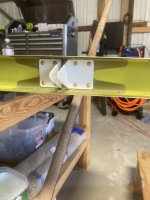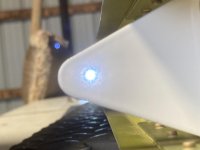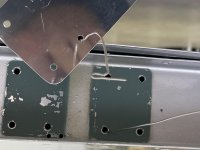Desert Rat
Well Known Member
I just knocked this out on a new uninstalled horizontal stab. Wasn't that hard, but I thought I'd throw a few observations out there for other folks.
This requires both an internal and external doubler if spar cracks are already present, or just an external doubler if it's accomplished as a preventative measure. If you're using Cherry rivets to install the new steel hinge brackets, be aware that Vans ships two different lengths of cherries in the same bag to cover both situations.
If you are doing this as a preventative measure and aren't installing the internal doubler you can minimize your paint touchup work, by with just drilling out 6 skin rivets top and bottom, plus the inspection hole in the end rib.
Since I was able to work on mine is on the bench and it's not painted, it made more sense to just open it up. That way I can skip drilling the inspection/debris removal hole in the end rib and also skip the cherry rivets.
On the top flange I removed the 6 rivets that will be common to the spar flange and the new doubler. On the bottom side, I opened up the entire bay. Probably around 20 skin rivets or so.
This allowed me to get in there with a small bucking bar and shoot on the new steel angles with conventional rivets, rather than trying to get cherries to set with a hardware store hand puller (and yes, I'm aware of vans video where they suggest lubricating them first).
It's hard to get it to show up in a picture, but once everything was done, the hinge line holes all still lined up appropriately. You can kinda see it below where I shined a flashlight in one end and took a picture from the other end. really good precise kit Vans, thanks!
This requires both an internal and external doubler if spar cracks are already present, or just an external doubler if it's accomplished as a preventative measure. If you're using Cherry rivets to install the new steel hinge brackets, be aware that Vans ships two different lengths of cherries in the same bag to cover both situations.
If you are doing this as a preventative measure and aren't installing the internal doubler you can minimize your paint touchup work, by with just drilling out 6 skin rivets top and bottom, plus the inspection hole in the end rib.
Since I was able to work on mine is on the bench and it's not painted, it made more sense to just open it up. That way I can skip drilling the inspection/debris removal hole in the end rib and also skip the cherry rivets.
On the top flange I removed the 6 rivets that will be common to the spar flange and the new doubler. On the bottom side, I opened up the entire bay. Probably around 20 skin rivets or so.
This allowed me to get in there with a small bucking bar and shoot on the new steel angles with conventional rivets, rather than trying to get cherries to set with a hardware store hand puller (and yes, I'm aware of vans video where they suggest lubricating them first).
It's hard to get it to show up in a picture, but once everything was done, the hinge line holes all still lined up appropriately. You can kinda see it below where I shined a flashlight in one end and took a picture from the other end. really good precise kit Vans, thanks!







